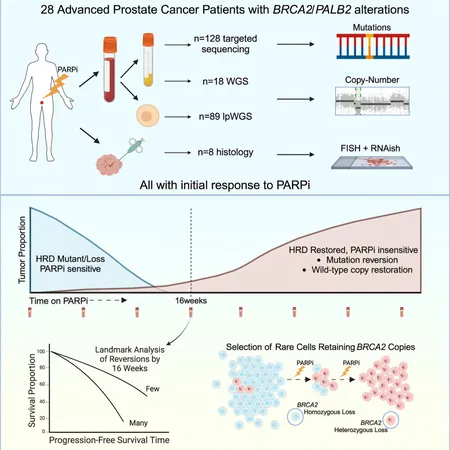
New Breakthrough in Prostate Cancer Treatment: Can You Predict How Long Patients Will Respond to Olaparib?
2024-11-21
Author: Daniel
New Breakthrough in Prostate Cancer Treatment: Can You Predict How Long Patients Will Respond to Olaparib?
In an exciting development for prostate cancer treatment, researchers have unveiled a new method to predict how long patients will benefit from the PARP inhibitor drug olaparib. This groundbreaking research, published in the journal Cancer Cell, promises to reshape the landscape of personalized cancer treatments.
A dedicated team from The Institute of Cancer Research in London has devised a straightforward blood test that detects specific genomic changes which impact the efficacy of olaparib against cancer cells. Their investigation revealed a compelling connection: the more reversion mutations—a type of DNA alteration—present in a patient, the shorter their survival time.
Significantly, patients lacking the BRCA2 gene, who had initially shown a positive response to olaparib, ultimately developed resistance as their cancer regained copies of the gene during treatment. This discovery highlights a critical limitation in using olaparib, as all patients eventually experience tumor growth after initial benefits.
The transformative potential of PARP inhibitors is becoming apparent, but the variability in treatment response underscores the need for better predictive measures. By understanding when patients are likely to stop responding to olaparib, healthcare providers can tailor treatment plans, potentially shifting patients to alternative therapies sooner and improving outcomes.
The researchers analyzed blood samples from 25 patients participating in the TOPARP-B clinical trial, a pivotal investigation into olaparib’s effectiveness in advanced forms of prostate cancer. Through this analysis, they identified that patients exhibiting higher levels of reversion mutations had an average survival of only 13.9 months, compared to 21.4 months for those with fewer mutations after just four months of treatment.
Olaparib operates by inhibiting cancer cell DNA repair mechanisms, a crucial process in how these cells survive and proliferate. The TOPARP-B trial specifically evaluated prostate cancer cases with mutations in key DNA repair genes, including BRCA1 and BRCA2. Unfortunately, as seen consistently, resistance to olaparib eventually develops, leading to the resurgence of the disease.
These findings elucidate the mechanisms of drug resistance and underscore an essential correlation that may guide future research. Interestingly, the study is the first to examine the relationship between genomic changes and clinical outcomes in prostate cancer patients using olaparib treatment.
The researchers uncovered an unexpected phenomenon: tumors that were initially missing the BRCA2 gene regained the gene post-treatment, allowing them to repair DNA, ultimately leading to treatment resistance. This insight significantly impacts future treatment strategies, as these tumors may not respond well to traditional chemotherapy, which is designed to damage DNA.
As scientists work to combat the resistance mechanisms of cancer cells, there lies an optimistic horizon in developing new therapies that can circumvent these adaptations. Professor Johann de Bono, a leading figure in this research, emphasized the need to remain proactive in treatment strategies to counter evolving tumor tactics.
This pivotal study not only opens doors for more effective treatments but also holds the promise of extending life expectancy and improving the quality of life for patients battling advanced prostate cancer. Simon Grieveson from Prostate Cancer UK also highlighted the emotional importance of this research, suggesting that early detection of treatment resistance could significantly enhance patients' time with their loved ones.
As research progresses, the hope is to develop precise treatments tailored to the genetic profile of each patient's cancer, ushering in a new era of personalized medicine that could make a substantial difference in the fight against prostate cancer. Stay tuned for more developments in this promising field!



 Brasil (PT)
Brasil (PT)
 Canada (EN)
Canada (EN)
 Chile (ES)
Chile (ES)
 España (ES)
España (ES)
 France (FR)
France (FR)
 Hong Kong (EN)
Hong Kong (EN)
 Italia (IT)
Italia (IT)
 日本 (JA)
日本 (JA)
 Magyarország (HU)
Magyarország (HU)
 Norge (NO)
Norge (NO)
 Polska (PL)
Polska (PL)
 Schweiz (DE)
Schweiz (DE)
 Singapore (EN)
Singapore (EN)
 Sverige (SV)
Sverige (SV)
 Suomi (FI)
Suomi (FI)
 Türkiye (TR)
Türkiye (TR)